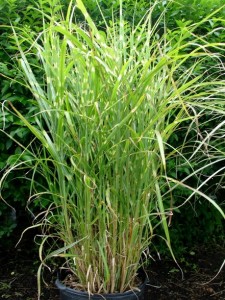Now that the worst of wintry weather is over, and the soil is workable, the number of garden chores is stacking up quickly. One of the chores that tends to get left off the list year after year is dividing ornamental grasses. Maiden grass (Miscanthus sinensis), in particular, tends to outgrow its space and die out in the center. This can also be an issue for larger fountain grasses (Pennisetum).
The general rule of thumb is to dig and divide these plants every 3-5 years. Although it’s a lot of work, dividing has a lot of benefits:

•It reinvigorates tired plants, allowing them to last for many more years in the garden.
•It keeps the overall size of the clump in check.
•It provides the gardener with free plants to use in the garden or give away to friends
•Divisions are guaranteed to be the same cultivar as the original plants. This can be very helpful to gardeners that don’t know the exact variety they have in the garden, but want to make a perfect match.
Once you “decide to divide”, do yourself a favor and enlist a friend. Large clumps have extensive, deep root systems that are extremely heavy, the more help the better. Before you begin, prepare the work area by laying down a tarp next to the plant and gathering your tools. Hedge trimmers, a heavy steel spade, sharp axe, wheel barrow, and a good pruning saw could all help the job along. I tend to use the spade to do all the digging and dividing, but a selection of tools is best. I’ve heard a reciprocating saw with a 12″ blade can be very handy to make the divisions once the clump has been liberated from the ground.
1) Cut back the desiccated foliage. Have your friend either tie the blades into a bundle or hold them together in his arms. Using the hedge trimmer, cut the foliage off between 6 and 12″ from the ground and discard it.
2) Dig the clump out of the ground. Dig around the plant, about a foot from the edge of the clump. The first time around, just focus on making a good track to work from. Continue to dig progressively deeper and under the clump, until it can be “popped” free from the soil, using the spade as leverage. If you have trouble pulling the clump out, try rocking it back and forth while your partner slides a tarp under it. Then pull it out of the hole on the tarp. Alternatively, cut the clump into smaller, lighter sections right in the ground and then pull them out.
3) Make the divisions. With a sharp spade, saw or axe split the clump in half. Continue to cut it up into more or less equal sections that can be replanted. Keep in mind, the ideal division will be from the outside of the clump and at least as big as palm of your hand. Don’t make divisions from the weak, woody center of the clump. This is the oldest part of the plant and will not transplant well.
4) Don’t allow the roots to dry out as you work. Although grasses are very tough, like any plants, they don’t like to have their roots dry out. Keep the bare roots covered as much as possible, and if they start to get dry, give them a light sprinkle with the hose.
5) Replant one division to replace the original plant. Grasses prefer lean soil that is not high in organic matter. Do not amend the backfill or add fertilizer. Just place the division in the hole and plant with the native soil. Gently press the soil against the roots as you back-fill to be sure the roots have good contact with the soil and that there are no air pockets.
6) Water the new plant well. Make a berm around the plant with soil. Fill the berm with water and let it drain, then fill it one more time. As the plant roots and new top-growth appears, it will still need regular water. Once the plant is established, flatten out the berm and mulch around the base.
7) Pot up what you can’t plant right away. Ornamental grasses are a great gift for your fellow gardener, why not pass a few along? * Never feel guilty for discarding extra plants if you have no use for them. They are better in the compost than an annoyance to water or jammed into places in the garden they shouldn’t be.
